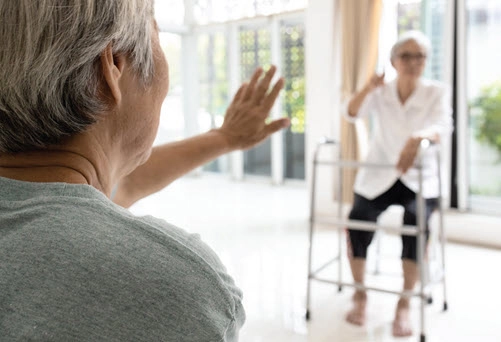Hint: ‘Compassionate care’ situations encompass more than end of life.
States across the nation are pausing or reversing their reopening strategies, and nursing facilities should be especially conservative with their visitation policies to keep their residents safe. However, there are some situations in which residents are allowed visitors — and creative ways to ensure resident and staff safety.
One important point: Phases of reopening rely mostly on hyperlocal transmission realities. Generally, the Centers for Medicare & Medicaid Services (CMS) recommends no visitation until or unless there have been no new “nursing home onset” cases of COVID-19 in the past 28 days. Facilities and referral hospitals also must be sufficiently staffed, have enough personal protective equipment (PPE), and hospitals must have bed capacity in both wards and intensive care units.
Understand Staffing Requirement
If you’re wondering about what exactly constitutes a safe staffing level, look to your state, but ultimately you may have to make the call on your own. “One answer does not fit all — some states have staffing level requirements, most do not,” says Jane Belt, MS, RN, QCP, RAC-MT, RAC-MTA, curriculum development specialist at American Association of Post-Acute Care Nursing (AAPACN) in Denver.
The May 18, 2020, quality, safety & oversight (QSO) memorandum defines adequate staffing as “no staffing shortages and the facility is not under a contingency staffing plan.”
“It is still up to each facility; many are allowing outdoor visits with mask and social distancing. Family need to check with the facility,” Belt says.

Know These Exceptions
CMS has said from the beginning of the pandemic that visitors should not be barred in compassionate care situations and have provided end of life care as an illustrative example. However, in a recently released Frequently Asked Questions (FAQs) on Nursing Home Visitation, CMS clarifies that other situations qualify. For example, a resident who moved into a facility from a family care situation may experience trauma at the sudden change of environment and inability to see family, and careful visitation may alleviate that immense stress. Similarly, a resident who has recently lost a family member or friend may be considered in a compassionate care situation as well.
CMS is careful to point out that such visitation should not be routine, and that all measures of COVID-19 prevention should be taken, including physical distancing and hand hygiene; also, everyone involved in the visit should wear cloth or other facemask coverings for the duration of the visit. Facilities should evaluate each situation on a case-by-case basis with state leaders, families, and the appropriate ombudsman to determine whether it qualifies as compassionate care.
Residents should always have immediate access to their state ombudsman (and vice versa). The visits do not need to be face-to-face if there are concerns about infection control, but the facility must facilitate another method of communication, such as a telephone call. CMS defines state ombudsman as a critical resource for residents and their families, and so facilities should prioritize figuring out a way to conduct a safe-as-possible way for the ombudsman to visit in person as soon as possible.
Get Creative With Spacing
Even if your facility and area are not meeting the requirements for Phase 3 of reopening (see more information about the various phases by reading the White House guidelines for Opening Up America Again), your facility can facilitate ways for healthy residents to visit with healthy family members.
Some facilities have taken advantage of the flexibility in the guidelines to set up outdoor spaces. Facilities must screen all visitors for COVID-19 symptoms, and residents as well, and follow all recommendations with physical distancing, using a facemask or face covering for the duration of the visit, and practicing appropriate hand hygiene. CMS recommends limiting the number of visitors per resident, and strictly controlling the total amount of visitors allowed at any one time. However, because transmission and therefore safety are so localized, CMS encourages facilities to work with their local and state health departments to make the appropriate determinations.
